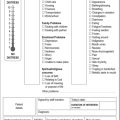9 Caring for the patient undergoing surgical cancer treatment
Introduction
• Increased knowledge of the natural history of cancer biology and an understanding of how cancers develop and behave.
• The development of diagnostic techniques: this has increased the accuracy of staging and grading, ensuring that surgery is used appropriately and improves surgical outcomes. For instance, it may be inappropriate for a patient with advanced secondary disease to undergo surgery which will not eradicate the disease or offer benefit. More detailed diagnosis often reduces the need for radical surgery, reducing the physical and psychological impact as well as improving the overall outcome. A good example of this is the introduction of sentinel node biopsy (Farrant 2004). Previously, when a woman underwent a mastectomy for breast cancer, the surgeon would routinely remove some or all of the lymph nodes from her armpit. This often meant that women experienced long-term lymphoedema (swelling) and weakness in the affected arm. Now during surgery, the surgeon injects a blue dye (sometimes with a radioactive tracer) into the tissue close to the cancer. The dye drains into a number of the lymph nodes; these are then known as the sentinel nodes and are removed to see if they contain cancer. If they are positive then the patient will most likely have a second operation to remove most of the lymph nodes under the arm.
• New microsurgical techniques such as laparoscopic and endoscopic procedures: these allow more conservative treatment, having less of an impact on physical functioning and appearance as well as a shorter postoperative stay.
• Since the Calman Hine report (DH 1995), surgical teams are dedicated to specific types of cancers. Surgeons must undertake a number of specific procedures a year to ensure competence, and all procedures are monitored locally, regional and nationally to ensure quality standards and equity.
• Recovery time in hospital has reduced as a result of the introduction of enhanced recovery programmes. These involve extra pre-, peri- and postoperative hydration and nutrition; regular analgesia; early removal of catheters/drains; and increased exercise soon after surgery (Slater 2010).
• The introduction of ‘rapid discharge programmes’ following surgery has improved physical and psychological recovery, such as the introduction of discharge after 23 hours from returning to the ward following breast surgery (DH 2007).
Read Preoperative care, Section 1 in Pudner (2010) (see References). Write a preoperative plan of care to meet the physical and emotional needs of a surgical patient you have cared for.
http://www.nmc-uk.org/Nurses-and-midwives/Advice-by-topic/A/Advice/Delegation/ (accessed November 2011).
http://www.nmc-uk.org/Documents/Guidance/nmcGuidanceRecordKeepingGuidanceforNursesandMidwives.pdf (accessed November 2011).
With less time in hospital postoperatively, patients and carers are increasingly required to manage the consequences of surgery. To do this, they require clear, understandable, tailored information. This includes having the opportunity to discuss with their medical consultant the nature of their surgery and its progress prior to leaving hospital, as this will lessen their anxieties and provide much needed information prior to their post-discharge review meeting in the outpatients clinic (Mitchell 2010).
What rehabilitation do they require?
Are there any household alterations required before discharge?
Which other multiprofessionals need to be involved?
What information does the patient and their family need?
Read the Royal College of Nursing discharge guidelines:
http://www.rcn.org.uk/__data/assets/pdf_file/0011/78509/001376.pdf (accessed November 2011).
NMC Domain 1: 1.3; 1.4; 1.5; 1.6
Caulfield H. Vital notes for nurses: accountability. Edinburgh: Wiley-Blackwell; 2005.
Department of Health. A policy framework for commissioning cancer services. London: Calman-Hine report). HMSO; 1995.
Department of Health. The cancer reform strategy. London: HMSO; 2007.
Farrant A. A kinder way to stage breast cancer. Cancer Nursing Practice. 2004;3(9):12–15.
Ford L. Consent and capacity: a guide for district nurses. British Journal of Community Nursing. 2010;15(9):456–460.
Mitchell M. A patient-centred approach to day surgery nursing. Nursing Standard. 2010;24(44):40–46.
Pudner R. Nursing the surgical patient, 3rd ed. Edinburgh: Baillière Tindall; 2010.
Slater R. Impact of an enhanced recovery programme in colorectal surgery. British Journal of Nursing. 2010;19(17):1091–1099.
Randle J., Coffey F., Bradbury M. Oxford handbook of clinical skills in adult nursing. Oxford: Open University Press, 2009.
Rothrock J.C., Alexander S. Alexander’s surgical procedures, 14th ed. St Louis: Mosby; 2011.
Wicker P., O’Neil J. Caring for the perioperative patient (essential clinical skills), 2nd ed. Edinburgh: Wiley-Blackwell; 2010.


